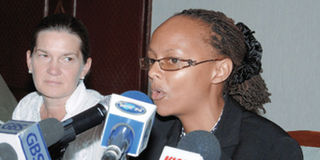Researchers close in on malaria vaccine

PHOTO | SALATON NJAU Dr Patricia Njuguna (R), the principal investigator in malaria vaccine research in Kenya, addresses the press on the outcome of phase three of trials in Nairobi on November 9, 2012.
What you need to know:
- The vaccine, known simply as RTS,S, is expected to be available for public use in 2014 subject to approval by the Ministry of Public Health
- Speaking on Friday at a conference in Nairobi, the scientists involved in the research said the vaccine would give a lifeline to many families in Africa
- An estimated 655,000 people from sub-Saharan Africa die of malaria annually with children below five the worst hit, according the World Health Organisation (WHO)
Researchers are close to producing a new malaria vaccine that could see the number of deaths from the disease drop significantly in Africa.
The vaccine, known simply as RTS,S, is expected to be available for public use in 2014 subject to approval by the Ministry of Public Health.
Results from the recent large-scale third stage of trials show that the vaccine can protect infants against the deadly disease.
The vaccine is to be administered to children in three doses.
Speaking on Friday at a conference in Nairobi, the scientists involved in the research said the vaccine would give a lifeline to many families in Africa.
Tool kit
In Kenya, the research is being undertaken by scientists based at the Centres for Disease Control and Kenya Medical Research Institute.
“An effective malaria vaccine would be a welcome addition to our tool kit, even as we record significant progress in recent years,” a principal investigator, Ms Patricia Njuguna, said.
“When administered along with standard childhood vaccines, the efficacy of RTS,S in infants aged six to 12 weeks at first vaccination against clinical and severe malaria was 31 and 37 per cent respectively,” Mr Salim Abdulla, a Tanzanian researcher, said.
He noted that the efficacy level observed with the dosage last year among children aged five to 17 months against clinical and severe malaria recorded 55 per cent and 47 per cent success rates.
An estimated 655,000 people from sub-Saharan Africa die of malaria annually with children below five the worst hit, according the World Health Organisation (WHO).
In Kenya, malaria is one of the top three killers among infants along with pneumonia and diarrhoea.
The 2010 Kenya Demographic Health Survey results showed that at least 84 per cent of children below 15, which translates to over six million people, are at the risk of contracting malaria.
The survey also indicated that over 19,000 infants succumb to the disease annually in Kenya.
Though the current success rating is lower than the one reported last year, Mr Abdulla said the information will enable the team gather and analyse more data from the vaccine trials.
“This will help to determine what factors might influence efficacy against malaria and to better understand the potential of RTS,S in our battle against this devastating disease,” he said.
Ms Njuguna said they will provide more data for analysis to enable the public to understand the findings better.



